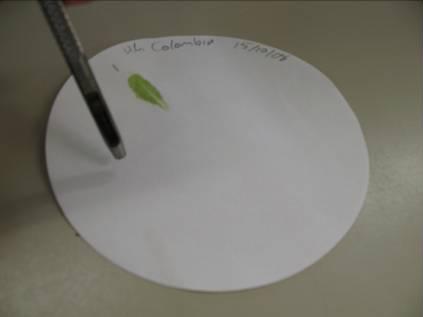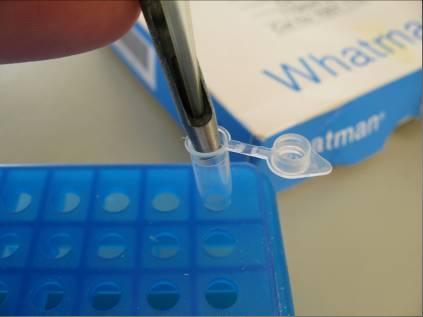Abstract
This protocol was developed to rapidly obtain genomic DNA from both Arabidopsis thaliana and Medicago truncatula for use in PCR-based analysis. This method has been used to screen large numbers of transgenic plants to confirm the presence of a T-DNA and could be applied to any PCR-based screening. Please note that the results are reproducible for most of the plants investigated however plants with softer leaves seem to give the best results.
Materials
-Non-absorbent disposable sheet –Parafilm is recommended.
-Pestle with a flat base –A 50ml falcon tube works.
-Absorbent paper –Whatman filters recommended.
-Hole punch –Kai biopsy punch (3mm) gave good results.
-Gloves and forceps
Method
1 – Place parafilm onto a clean surface and a filter paper onto the parafilm. Snip off a piece of tissue and place onto the filter paper.
2 – Place a second sheet of parafilm over the tissue and apply pressure.
3 – Remove the film and the plant material and you should get a nice ‘juicy’ impression of the crushed tissue. Leave this to dry at room temperature, it often takes an hour or so for larger leaves.
4 – Once dry the filter can be hole punched and the disks dropped straight into a PCR mix. Be aware the paper will soak some of the PCR so small volume reactions (20 μl) may have issues depending on your disk size. Each impression can give several punched holes so repeats can be easily performed. The filter papers will be good to use for several months, I have some which are >1 year and still gave the expected product.
Care should be taken at all times to ensure that cross contamination from unwashed punches, disks touching or the punch block should be avoided. I havn’t yet had a primer or primer set that have amplified anything from the paper alone, it is important to check this every time as it may happen.
Background thinking
Although not necessary for a protocol to work it is often useful to know the thinking behind the method development, this may help a user tailor the method to sightly different approach or aid trouble shooting.
After watching too much CSI I saw that gDNA was surprisingly stable at room temperature and could be isolated from an array of juices using cotton buds etc. I had many hundred transgenic lines to PCR screen to confirm the insertion of a T-DNA (this also allowed confirmation that labels hadn’t been mixed or seed spilt etc.) The direct addition of crushed material to a taq PCR would often give a result but it wasn’t giving repeatable clean products, also it meant material would need to be stored at -80°C if I wanted to repeat a sample. The common opinion was that cytosolic components had a negative affect on the PCR so I tried various methods of absorbing plant juice, I hoped that by tangling the DNA/protein/sugar mix in the fibres of paper would in effect separate them, then the polymerases would have a better shot at running along the relatively short length being amplified. For Arabidopsis thaliana and Medicago truncatula the filter paper worked well, for more crunchy leaves from plants such as Ricinus communis I could get a green juice out but not much luck with PCR products, it could be the more robust leaf architecture prevented genomic DNA leaking out as well or it could have been inhibitory factors.








